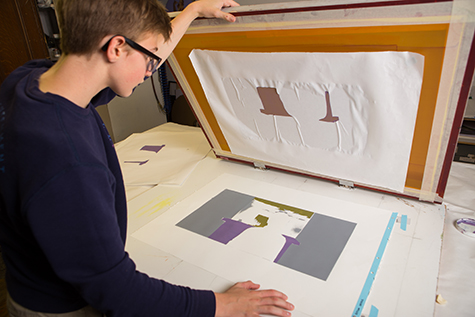ChatGPT said: The complete guide to 10:9 Design Screen Printing Texas
The Vital Guide to Comprehending Screen Printing and Its Versatile Uses
Screen printing has a rich history that dates back to old times, evolving right into a sophisticated strategy made use of across different sectors today. This guide checks out the intricacies of the screen printing process, describing its applications in advertising and marketing, style, and home decoration - 10:9 Design LLC Company. Comprehending these principles can open up innovative capacity for both commercial and imaginative jobs. The complying with areas will expose crucial tips and methods to enhance one's screen printing endeavors
The History of Screen Printing
Screen printing has roots that map back centuries, its development shows the technological and imaginative innovations of different societies. Coming from old China, the strategy was originally used for embellishing fabrics and later infect Japan, where it became important to Ukiyo-e woodblock printing. The approach moved to Europe in the 18th century, where it gained popularity amongst artisans and industrial printers. The invention of picture emulsion in the 20th century reinvented screen printing, permitting for more elaborate layouts and greater performance. Artists like Andy Warhol additionally drove its appeal, utilizing the tool to develop renowned jobs that blended commercialism and great art. By the late 20th century, screen printing had developed itself as a functional strategy, employed in fashion, advertising, and fine art. Today, it proceeds to advance, integrating digital innovation and increasing its applications throughout various markets.
The Screen Printing Process Explained
Screen printing transforms artistic visions into substantial layouts with a collection of specific steps. An image is created and then transferred onto a screen, generally made of great mesh textile stretched over a framework. A light-sensitive solution is related to the screen, which is exposed to light, hardening in locations not covered by the image. After rinsing the unhardened emulsion, a pattern is developed.
Next, the screen is put over the substrate, whether it be material, paper, or an additional product. Ink is then pressed through the open areas of the pattern using a squeegee, depositing the design onto the substrate below. This process can be repeated for numerous colors, needing separate displays for every color. The printed product is healed using heat to guarantee the ink adheres effectively, resulting in a durable, vivid design prepared for use.
Kinds Of Screen Printing Techniques

In addition, specialized strategies, such as discharge screen printing, eliminate dye from the textile to produce softer prints, while foil screen printing applies metallic foil to attain a shiny finish (10:9 Design reviews). Each technique offers distinctive characteristics, accommodating various innovative needs and manufacturing ranges, eventually increasing the opportunities within the screen printing domain name
Applications of Screen Printing in Different Industries

Additionally, the signage and advertising markets use screen printing for developing captivating display screens and banners. This approach allows for bold colors and intricate layouts that catch attention. In electronics, screen printing is used for using conductive inks to circuit boards, crucial for part links. Furthermore, the home decoration market accepts screen printing to create distinct layouts on textiles and wall surface art. On the whole, screen printing acts as a vital tool throughout diverse fields, boosting products with individualized and visually attractive graphics.
Tips for Effective Screen Printing Projects
While carrying out a screen printing task, cautious attention to information can considerably boost the final result. First, picking high-grade products is vital; this consists of the screen, inks, and substratums. Making use of ideal mesh matters can influence ink deposition and information resolution. Prep work is just as vital; comprehensive cleaning of displays and proper direct exposure times assure crisp prints.
Next off, exact registration is vital for multi-color prints. Making use of positioning tools can help achieve exact layering. Additionally, screening prints on scrap materials prior to manufacturing assists determine website potential issues without throwing away sources.

Regularly Asked Concerns
What Products Are Best for Screen Printing on Textile?
Cotton and polyester blends are suitable for screen printing on material due to their resilience and ink absorption. In addition, specialized textiles like silk or canvas can create unique structures and coatings, boosting the total layout quality.
How Do I Clean and Maintain Screen Printing Equipment?
To keep and clean up screen printing tools, one need to consistently wash displays with proper solvents, examine squeegees for wear, lubricate relocating parts, and shop all things in a dry, dust-free setting to prolong their life-span.
What Are the Ecological Impacts of Screen Printing?
Screen printing can have significant environmental influences, including chemical waste from inks and solvents, water use throughout cleaning procedures, and power consumption. Sustainable techniques and eco-friendly materials are necessary for lessening these adverse impacts.
Can Screen Printing Be Done in your home Successfully?
Screen printing can be effectively done at home with the ideal materials and strategies. Enthusiasts can create high quality prints, though success depends upon their skill degree, equipment, and understanding of the procedure involved.
What Are the Costs Linked With Starting a Screen Printing Business?

Beginning a screen printing company includes costs for tools, materials, and work space. Preliminary expenditures typically vary from a few hundred to numerous thousand dollars, relying on the range, high quality of equipment, and wanted production capability.
Screen printing has an abundant history that dates back to ancient times, evolving into an innovative technique made use of across various markets today. An additional technique, rotating screen printing, employs cylindrical screens, helping with continuous printing on textile rolls, thereby enhancing effectiveness for large manufacturings. In addition, specialized methods, such as discharge screen printing, remove color from the material to develop softer prints, while aluminum foil screen printing applies metallic foil to achieve a shiny coating. In the style field, screen printing is commonly utilized to create vibrant layouts on garments, enabling brand names to showcase their distinct designs. Cotton and polyester blends are ideal for screen printing on material due to their longevity and ink absorption.